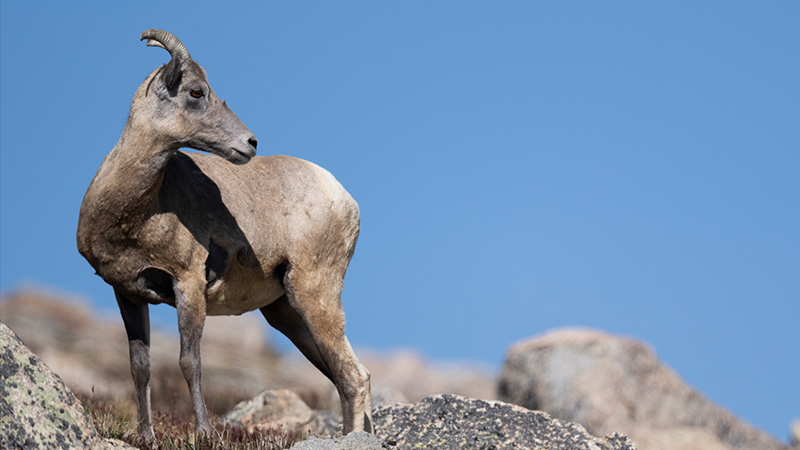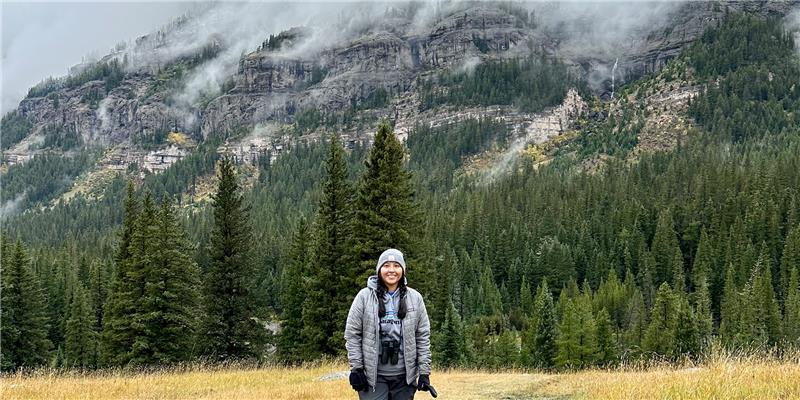December 14, 2023
Ancient Lands,
New Ground
HOW NAVAJO NATION GRAD STUDENT JAMIE BEGAY
IS CHANGING THE FACE OF NATIVE CONSERVATION
The new Indigenous Bighorn Fellowship, a multi-entity collaboration, aims to break down educational and vocational barriers for Native conservationists. Here’s how inaugural recipient Jamie Begay is poised to do just that—and why her work with Navajo Nation bighorn sheep is likely to impact both wildlife and humankind.
Bighorn: From Thriving to Striving
When the Diné people first settled in the American Southwest nearly 1,000 years ago, wild desert bighorn sheep (tse’tah dibe, in the Navajo language) roamed the remote rocky plateaus in great numbers. Early residents of the stark wilderness that would become the Navajo Nation relied on these large ungulates for food and clothing as well as medicinal and ceremonial materials.
But as human populations grew and domestic sheep encroached upon the fragile ecosystem, desert bighorn experienced a catastrophic decline—decimated by habitat loss, competition for food, overharvest and disease transmission. By the 1990s, only 34 individuals remained on Navajo lands; today, national populations are at a mere 5% of their historical abundance.

An Intricately Layered Challenge
The Navajo Nation Department of Fish and Wildlife (NNDFW), in collaboration with tribal authorities and conservation consultants, has been working for nearly 30 years to rebuild these herds. Populations had risen to around 600 by 2016, but a recent pneumonia epidemic now threatens that recovery. As the NNDFW look to the future of bighorn recovery, they’re faced with a two-pronged challenge: how to address critical wildlife threats today—while proactively preparing Diné human resources for conservation success tomorrow.
Historically understaffed, the NNDFW has struggled not only to fund its wildlife biologist positions, but also to fill them with qualified Native candidates. The Navajo Nation is sprawling, spanning 18 million acres across Utah, Arizona and New Mexico. But its total population is just 400,000—about the size of Aurora! And with 35% of tribal members living below the poverty line, the level of education necessary to hold these positions seems chronically unattainable.
A Sustainable Long-Term Solution
In December of 2020, Denver Zoo joined these ongoing desert bighorn conservation efforts. Supported by a $260,000 grant from the Bureau of Indian Affairs and the U.S. Fish and Wildlife Service, our conservation and animal health experts partnered with leaders from the NNDWF, Colorado State University and Wildlife Conversation Society to begin a multi-year research and restoration project.
As mentioned above, though, qualified human resources from within the Native community are essential to the long-term success of this program. That’s why part of the project grant was earmarked for the Indigenous Bighorn Fellowship, a new scholarship supporting graduate studies in wildlife biology for budding Diné conservationists. First-time recipient Jamie Begay was hand-picked by the collaborative team to lead the project’s immersive second phase.
Cultural Connection + Conflict
Jamie, who comes from a long line of Navajo sheep herders, is uniquely qualified for the new fellowship—and for the future it’s intended to foster. As an undergrad, Jamie was studying environmental science at Diné College when she was introduced to the field of conservation biology through a mule deer internship. A lover of the outdoors who worked on her family’s ranches, Jamie quickly took to fieldwork…and easily caught the eye of her mentors.
CSU Professor Joel Berger and NNDWF Wildlife Biologist Jessica Forte saw in Jamie a bright and eager future conservation leader, encouraging her to apply for the first-ever Indigenous Bighorn Fellowship. “When they presented this opportunity to me, I was honestly speechless.” says Jamie. “Growing up on the rez…it’s a tough life. I have two boys, and I want to set an example for them—but not a lot of people within my community have this ability.”
But it’s precisely this background that has imbued Jamie’s work with a deeper significance. “For me, conservation is more than just protecting natural habitat,” she says. “It’s a holistic approach to preserving culture and sustaining livelihoods for native families and communities.” For her people, Jamie continues, the natural world is deeply intertwined with tradition and culture. The Navajo clan system, which tracks human kinship through generations, does this through one’s relationship to local landscapes and wildlife. She says, “This is how we introduce ourselves:
I am Coyote Pass
Ma’ii deeshgiizhnii nishłí.
Born for the Red Running into the Water People Clan
Táchii’nii éí báshíshchiin.
My maternal grandfather are of the Big Leaf People
Bit’ahnii éí da’shícheii.
My paternal grandfather are of the Water Edge People
Tábąąhá éí da’shinalii
That is who I am as a Navajo Woman.
Akítéégo Diné asdzaaní nishłí.”
But while tradition and spirituality bind her to the species and spaces she’s working so hard to protect, Jamie’s path has not been without cultural barriers. “On the reservation, there are not many women working with wildlife. My family is very traditional, with a lot of medicine men and women on both my paternal and maternal sides. At first, they were not too happy about my work on the mule deer project; they wanted me to go through a protective ceremony as a woman in this industry. Now, they are much more supportive.”

Clearing the Path Forward
Today, domestic sheep remain an important part of Navajo culture, supplying sheep herding families like Jamie’s with meat and wool. In Phase 1 of our desert bighorn project, we captured and collared 90 individuals to better understand disease epidemiology and herd movements. In Phase 2, under Jamie’s leadership, we’ll work alongside Diné herding families to track the movements of domestic sheep herds—identifying transmission hot spots and working towards a solution that protects wild bighorn with minimal impact on Navajo life and livelihood.
As for the project’s impact on Jamie personally, she says, “This opportunity is huge for me. Giving up is not an option…not only for myself but for my husband and two boys, for the next generation, so I can help to restore the natural balance that we grew up hearing about from our elders.” Stefan Ekernas, Denver Zoo’s Director of Colorado Field Conservation, believes this is the fellowship’s ultimate goal. “It’s an honor to be able to fill these gaps temporarily,” he says. “But for us, conservation is also about building capacity, so that the Navajo Nation is set up for long-term success.”
And Jamie’s impact? Her graduate studies are already well under way at Colorado State University, and she will play a key role in Phase 2 of our ongoing Desert Bighorn Project. Only time will tell what other great things she’ll go on to accomplish—personally, professionally and on behalf of her Diné community. We will certainly be watching.
Follow Denver Zoo on Facebook, Instagram, Twitter, TikTok and LinkedIn for updates on Jamie's journey—and our 3,000 incredible animals!
Support
As a non-profit organization, Denver Zoo relies on your support to help fund important conservation efforts like the Desert Bighorn Project, the Indigenous Bighorn Fellowship + many more. Click the button below to support us!
Subscribe
Be first to hear the latest animal updates, important stories and details about all the fun happening around Denver Zoo.
Tags
-
 January 13, 2021
January 13, 2021Helping the Herd
How Denver Zoo is Conserving Bighorn Sheep on the Colorado Plateau By Stefan Ekernas, Rocky Mountain/Great Plains Program Director…

